Astoria
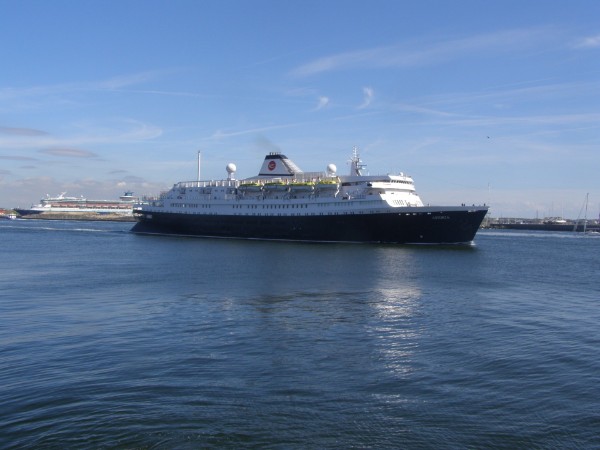
Astoria had been a frequent visitor to IJmuiden as well as Amsterdam under her former names Athena and Azores, but also as Astoria she seems to be able to find her way to The Netherlands. She is seen here, between the IJmuiden piers at the 31st of may 2017, sailing in charter for Rivages du Monde. Behind her. you can also spot Pullmantur's Monarch, the former Monarch Of The Seas of Royal Caribbean.
Background
The second worldwar had a devastating effect on many shippinglines sailing from the old world to the new. The Swedish American Line was one of them. The company was building a new flagship under the name of Stockholm in the late 1930's, but this ship was destroyed in a fire in december 1938. Quickly, a new ship was ordered and built from the same wharf to almost the same design and specifications. This ship was also named Stockholm and was to enter service in the early 1940's. She was finished just when war started, but because of the outbreak their was no lineservice to sail for her. This ship was built in Italy and because of this lack of earnings, she was sold to the Italian government as Sabaudia. Sweden, still a neutral country, did not mind selling the ship to Italy, at that time a fascist state and partner to Germany in the war. Sabaudia was eventually sunk in 1944 near Triest.
Throughout the war, the company had two passengerships under their ownership, the 1904-built Drottningholm (the former Allen Line ship Virginian) that had entered Swedish service in 1920, and the 1924-newbuilt Gripsholm. Both had been chartered to the US government as repatriationships to sail across the Atlantic with officials between the countries that were at war. Being a neutral country, it was impossible to use the ships for any kind of real war-efford like the ships of most countries that were in use as troopships, hospitalships or warships. At the end of the war, Drottningholm again opened the normal sailings to New York from Stockholm in march of 1946.
Construction
In the last years of the war, Swedish American Line was thinking about again another new Stockholm, as their last two Stockholms were lost in just a few years. In spite of huge protests from the companies offices and even the chief executive, the choice was now to built a smaller sized ship that would mostly be for cheaper crossings in less luxurious style. Maybe a strange choice for a company that had been offering sailings in the style of Holland America Line since their origins in 1914. But the world did just recover from a huge war after a great financial crisis so a lot of people wanted to search for better life in America and those were not the rich folks.
Astoria as Athena as seen leaving IJmuiden at the 6th of august 2011, one year before the collapse of Classic International Cruises.
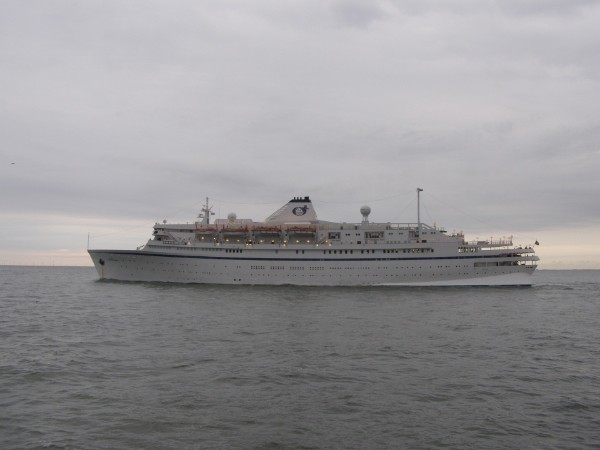
The new Stockholm was launched at the 9th of september 1946 at the Gotaverken Arendal in Göteborg, Sweden. Her yardnumber was 611. The ship had a tonnage of 11.700 when she was built and there was room for 113 passengers in first class and 282 passengers in tourist class. It was the fourth time this name was used in a company that just exsisted from the 1910's onwards. Of course this was because of the both Stockholms that had been lost during of just before the war. The new ship had her trials in october of 1947.
Early years before 1956
She was the smallest ship on the North Atlantic route since she began her services at the 21st of february 1948. At this date, she began her first budget crossing to New York from Stockholm. She was, despite her size, still the largest passengerliner that had ever been contructed in Sweden as the company had all other ships built at foreign wharves. Normally, she would sail the Atlantic route through summer and cruises in wintertime, as weather was not very favorable and conditions in the Baltic Sea could be bad during the colder months.
In 1953 the ship was rebuilt at the AG Weser Seebeckwerft in Bremerhaven, Germany. The first class was reduced to 86 passengers only and the tourist class was extended to 584 passengers. Also her tonnage grew to 12.644. In the 1950's, sailings to America were popular, and the company made good profits. At this time, the ship looked very different from now, her superstructure was much shorter and she had two large masts.
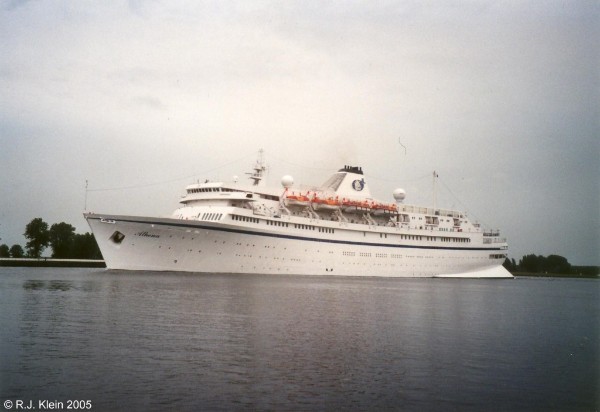
Athena near Spaarnwoude at the Northsea Canal at the 20th of may, 2005.
The Andrea Doria collission
A rather small ship like this would not have been noticed by the general public if her carreer would have gone on without incident. But Stockholm was part of the biggest maritime tragedy in peacetime since the sinking of Titanic when she collided with the Italian flagship Andrea Doria of the Italia Line at the North Atlantic in 1956. The Italian ship, build in 1953, was the pride of the Italian merchant fleet and her popularity was spread throughout Europe. In thick fog the two ships collided, and Stockholm sliced through the bow of the Italian liner killing two persons instantly. She bounced of and disappeared in the mist again. The Italian captain called for help and Stockholm, although badly damaged herself, rushed back to the place of impact. On the Swedish liner, five people had died also. But the tragedy was much worse on Andrea Doria where 46 people had been killed. One strange thing that happened aboard Stockholm was the story of the fourteen year old Linda Morgan, who was found on the bow, alive. The bow of Stockholm sliced under her bed when she was sleeping together in a room with her stepsister and stepfather, who both had been killed, and her mother, who survived. She had a broken arm, but when she was found by a sailor of Stockholm, she surprisedly asked where she was, as she had been on the Italian ship before. Although damaged severely, the crew of Stockholm managed to get the ship back to the place of impact and they rescued the surviving Italian people and the ship headed back to New York, under her own power. Her bow, although damaged, was provisionally repaired. Of course, also the North Atlantic's own St.-Bernard Ile de France was there to pick up Italian passengers next to four other ships, making a total of six. Captain Calamai of the Andrea Doria firstly refused to leave his ship, but was later forced by his crew to do so as all passengers had been evacuated or dead. He was never to return to sea and his ship, the Andrea Doria, sank eleven hours after the collission. Although it is widely known what had happened, the investigation naver really made clear who was to blame and both companies accused eachother for the incident. One of the two captains had read the radar wrongly, a fairly new invention, and instead of passing eachother the ships were sailing directly into eachothers path. One reporter of ABC who broadcasted about the collission was Edward P. Morgan, the father of Linda Morgan. Although he feared his daughter had died in the incident, during a broadcast the following night he learned she was still alive and this broadcast is known as one of the most emotional to date in the history of radio.
The wreck of Andrea Doria now is a popular but very hazardous divingspot, nicknamed 'Mount Everest' by divers due to the fact that at leat 16 divers have died trying to reach the wreck that lies in a depth of 240 feet under the surface. Hazardous currents and poor visibility make this dive so dangerous.
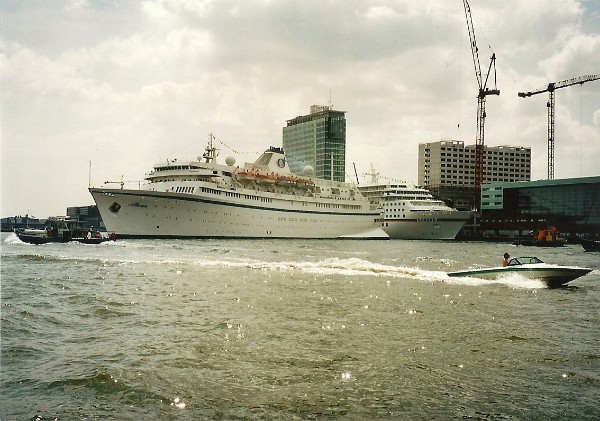
Athena in a very busy setting arriving in Amsterdam, berthing behind Hapag-Lloyd's Europa. This picture was made on the 22th of june, 2005.
Rebuilding and later carreer
Stockholm was repaired by Bethlehem Steel Company in Baltimore where her bow was totally replaced. She resumed service at the 5th of november of 1956. In 1960 the ship, less succesful after this tragic incident, was sold to the Freie Deutsche Gewerkschaftsbund (VEB Deutsche Seerederei) and renamend Völkerfreundschaft. She was rebuilt as a fulltime cruiseship and had accomodation for 568 passengers. Mostly, those passengers would be members of the Communist party, as well as workers and their families who were awarded with cruises in the Baltic and the Black Sea. Also, occational cruises to Cuba were undertaken. In 1985 her sailings ended and she was renamed Völker and laid up in the Oslofjord in Sweden. Her she remained between august and december, when she was brought over to Southampton. The next year she was again transferred back to Oslo under her new name of Fridtjof Nansen. There, she took on a new role as accomodationship for refugees.
Athena again, sailing towards IJmuiden at the 20th of may, 2005.
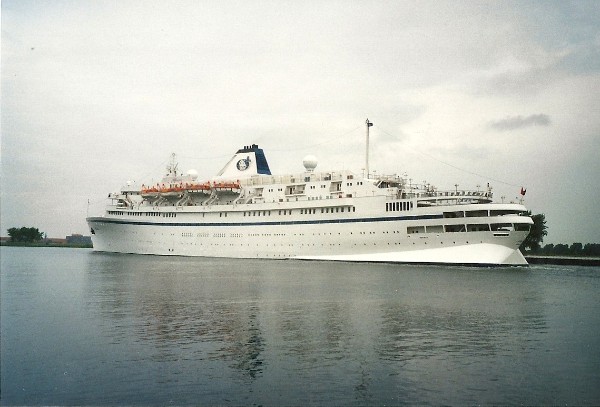
In 1989 she was bought by Starlauro Cruises of Italy. This company became known especially in 1985 when their ship Achille Lauro was hijacked by Palestinian terrorists who murdered one of her American passengers. The company planned a total rebuilding of the now 43 year old ship and a re-introduction of her for Mediterranean cruising. Not everone was pleased by the choice for the ship, as she was named 'la nave della morte' (the ship of death) due to the 1956 collission with Andrea Doria. Her intended name would be Surriento at first, but later the plan was changed and she was to be named Positano. But nothing came of this also and she remained laid-up at Genua untill 1992 when rebuilding started. In 1994, she was finally completed as the Italia Prima for the Italian company Nina Compania di Navigazione. She was also chartered out to the German Neckermann Seereisen but this charter ended in 1998 when she was used as an accommodationship for the Expo 98 World Exhibition in Lisbon. After this, she was used by Valtur Tourist for cruises from Montego Bay, Jamica to Mexico and around Cuba as Valtur Prima. The old ship was laid up again in 2001 in Havana, Cuba before she was bought by Festival Cruises, known as First Choice for Americans. Her new name was Caribe I. When this company went into liquidation in 2004, the ship was bought by Arcalia Shipping, a company that traded as Classic International Cruises. She was renamed again, now she sailed as Athena, the new flagship of Arcalia. She sailed mostly European cruises for over one year, before she was chartered out to several companies. On the 3rd of december 2008, the ship was attacked by pirates in the Gulf of Aden while she sailed on a voyage to Australia. At some point, some 29 pirateboats surrounded the ship, but high-preasure waterhoses used by the crew and a US Navy maritime patrol aircraft overhead prevented the pirates from boarding and the ship was able to sail on without anyone injured.
At the end of 2012, Classic International Cruises was declared bankrupt, a few months after the owner of the line died. The ships of the company were arrested in port, including Athena. At that time, it was 68 years after she was launched and nobody expected that she would be picked up by another line. The only option seemed to be the beaches of India. Great was the surprise, when a Portugese named Rui Alegre seemed to have bought the former Classic International ships, with the exception of Princess Daphne. He was going to form a new venture from the beginning of 2013 onwards under the name of Portuscale Cruises, based at Lisbon, Portugal. There was some sceptism, but the rebuilding of the ships took up very well and new names were given to all exept the Funchal. Her name and history had been always close to Portugal, of course. For Portuscale, Athena recieved the new name of Azores and she was totally refreshed for her new owner and now she looks almost smarter then ever. Azores was chartered by her new owners to Ambiente, a German tour operator who earlier chartered ships from Classic International. For them, it was planned to sail northern European cruises from march 10th 2014 onwards untill november of that same year. Her first cruise was be a re-positioning cruise from Lisbon to Bremerhaven. Sadly, due to low bookings, two of her first cruises had to be cancelled and from the 6th of june onwards, the charter was ended totally because of low bookings. The ship was delivered back to Portuscale, and was afterwards chartered to the British-based CMV Cruises from the beginning of 2015 onwards. Sadly, the Portuscale venture seemed to be a short one as the company ended its operations in 2015. In service for CMV, Azores lost her Portuscale colours at her funnel, as it was repainted with the new CMV logo on a white background. CMV used the ship for European cruises throughout 2015, but at the end of the 2015 season, it seemed that she was now more or less controlled by CMV as Portuscale was in severe financial trouble. The ship was renamed Astoria, in line with the Transocean Tours ship Astor, also owned by CMV, and sub-chartered out to Rivages au Monde. This French company used the ship for sixteen European cruises throughout 2016, from may 11th onwards. The name Astoria was of course earlier used for the sistership of Astor, now sailing for Saga Cruises as Saga Pearl II. This ship had been built in 1981, so the now second Astoria was built some 35 years before the first Astoria. In my knowledge this never happened in cruise history...
Nice fact also is that untill 2015, still two former Svenska Amerika liners were in operation. Next to the 1946-built Stockholm, also the 1965-built Kungsholm was still sailing. As Veronica, the latter was beached at Alang, India in late 2015 leaving only her almost twenty year older sister to keep the memory of the Swedish line physicly alive. In Sweden, an initiative is there now to revive the SAL-name and a design has been made for a new ship based on the Kungsholm. They have their own website, reachable via this link.
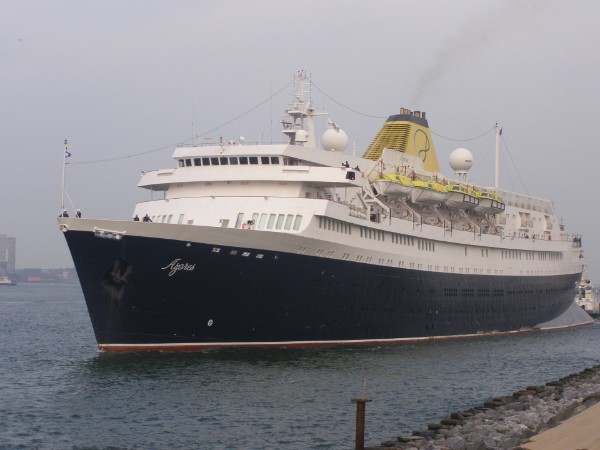
Under the name Azores the ship is shown above when she departed IJmuiden during her first voyage under this name. Although she sailed under charter for the German company Ambiente, she sports the colours of the fleet of Portuscale Cruises, her new owner and the successor of Classic Internatonal Cruises. The picture was taken on the 2nd of april 2014.

